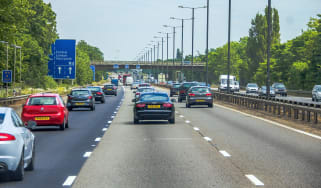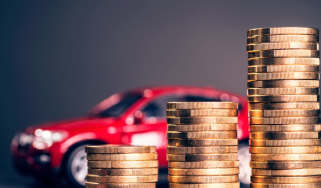How do I renew my driving licence or change the address?
Follow our step-by-step guide to find out how to renew your driving licence or change your licence details

All UK drivers are legally required to renew their driving licence photocard every ten years, or every three years for those aged 70 and older. It’s a straightforward process and can be completed either online or via the post.
It’s also important to keep your driving licence details up to date. If there is a change in your address, name, title or gender, you must inform the DVLA of the change. Failure to keep your driving licence up to date can result in a £1,000 fine.
 What is a V5C? Your car’s log book explained
What is a V5C? Your car’s log book explained
In this guide, we’ll cover everything you need to know about renewing your driving licence, including online and postal methods of renewal, as well as special circumstances where your driving licence may have to be renewed more frequently.
When will my driving licence expire?
As previously mentioned, both provisional and full licence photocards will expire automatically after 10 years. Note that your licence will expire exactly 10 years after it was issued, rather than the date you received it – you’ll be able to see your licence’s issue and expiry dates listed on the front of your photocard.
You will receive a driving licence renewal reminder from the DVLA in the post to your registered home address. In order for this to reach you, you must make sure that you inform the DVLA whenever you change address.
You are able to apply for renewal before your current licence expires and the new licence will be valid from the application date.
How do I renew my driving licence?
There is a different renewal process depending on whether you are under or over the age of 70, or if you have a particular medical condition or disability. In all cases, you must be a resident of Great Britain and not be disqualified from driving.
For those under 70, you have a choice of three methods:
- Online – Visit the Government’s licence renewal webpage and follow the instructions. You will need to create an account and pay a fee of £14, payable by debit or credit card. You will also need a valid UK passport, your current driving licence, addresses of where you have lived for the past three years and your National Insurance number, if possible.
- By post – You can apply for a renewed driving licence by post, using a D1 form that you can pick up at most Post Office branches. In addition to this form, you’ll also need to send to the DVLA your current photocard licence, a recent passport-style photograph of yourself and a cheque or postal order of £17 that’s payable to the DVLA.
- At a Post Office – You can renew your driving licence in person at your local Post Office too. Bring the renewal reminder letter that you received from the DVLA and your current licence. If none of your details have changed, then the reminder letter isn’t strictly necessary, but it's worth bringing if you have it to hand. A member of staff will take a new photograph of you and send it, along with your application, to the DVLA on your behalf. The process costs £21.50
Once you reach your 70th birthday, you are required to renew your driving licence, whether you’ve already renewed it within the past ten years or not. From then on, you will need to renew it every three years. Each time, you will have to confirm that you meet the minimum eyesight requirements and that you are not prevented from driving for any reason.
You should receive a D46P form in the post ninety days before you turn 70, which you can fill out and send off before your birthday. If you wish to renew online, you can do this up to ninety days before your birthday as well.
If you are aged 70 or older, then you can only renew your licence online or via post, but the process is free. For the online renewal process, you will need an email address, addresses of where you have lived for the past three years, a UK passport (if you want to change your licence photo) and your National Insurance number, if possible.
If you wish to renew by post, you can use the D46P that will be sent to you every three years by the DVLA. Don’t worry if you didn’t receive this – you can pick up a D1 form from your local Post Office and use that instead.
What if I have a medical condition or disability?
Some drivers may need to update their licence sooner due to medical conditions or disabilities. In these cases, you may need to renew your licence every one, two, three or five years, depending on the exact nature of your condition. Remember, it’s important to notify the DVLA if you develop a medical condition that could affect your driving as it could also void your insurance if you fail to do so.
The process for applying for one of these restricted driving licences is different to the standard one – the DVLA may have to contact your GP for an update on your condition, require you to undergo a physical examination or you may need to undertake an eyesight test or another driving test.
How do I change the address, name, gender or photo on my driving licence?
Like renewing your photocard licence, you can apply to have the address on your driving licence changed either online or through the post. Unlike a licence renewal, however, you won’t have to pay to have your address changed.
To apply online, you will need to be a UK resident and have your photocard licence to hand, your addresses from the last three years and your National Insurance and passport numbers. It goes without saying that you also must not be banned from driving when you apply for your address details to be changed.
For posted applications, you’ll need to send to fill out the ‘changes’ section on your D741 form (this should have come with your licence when you received it.) If you’ve lost this, you can get a D1 licence application form, available at your Post Office. You can change your address and photo at the same time by post if you wish, although this incurs a charge. You can do this online if you want to use the same picture as your passport and it costs £14.
To change it to a different picture not currently used on your passport, you’ll need to send your current photocard licence, a recent passport-style photograph of yourself, a £17 cheque or postal order that’s payable to the DVLA and the D1 application form by post. Changing your name and address at the same time also costs £17 and can only be done by post.
How long should it take for my new driving licence to arrive?
Once your application has been submitted, it should take up to three weeks for your new photocard licence to arrive in the post. Depending on how quickly it’s processed, your new licence could arrive within a week of your application being sent over.
If three weeks have passed and there’s still no sight of your renewed or updated driving licence, you may want to chase things up with the DVLA; telephone numbers and exact opening hours can be found on GOV.UK.
What are the penalties for not renewing or updating my driving licence?
If you drive after your licence has expired and you haven’t renewed it, you run the risk of facing very severe penalties. Driving without a valid licence means you could be fined up to £1,000, and you could also end up with penalty points on your licence once it’s been renewed.
There are very specific situations where you can drive without having a valid driving licence. For instance, you may be allowed to continue driving if your licence expires while your renewal application is being processed by the DVLA, as long as you’re still deemed medically fit to drive and haven’t been banned from driving on the public road.
You also run the risk of a fine of up to £1,000 if you don’t keep your address details up to date on your driving licence. However, you won’t need to change your address details if you’re moving into temporary accommodation and you can still be contacted at your personal address – meaning, for example, you won’t need to notify the DVLA of an address change if you’re a university student who’s studying away from home.
Car ownership made simple
Recommended

Classic car tax exemption: which historic vehicles qualify?
Most Popular
Tips & advice

Car dashboard warning lights: what does each symbol mean?

Electric car charging stations: public networks, charger types, apps and maps









